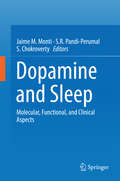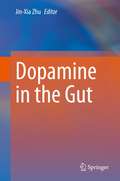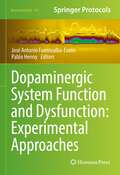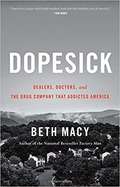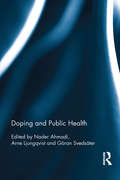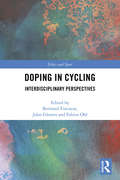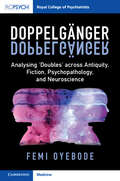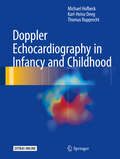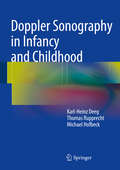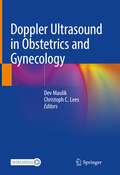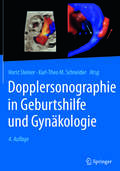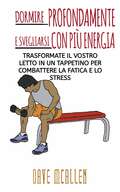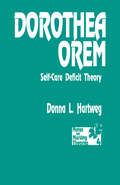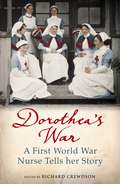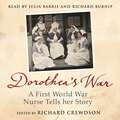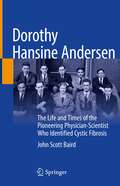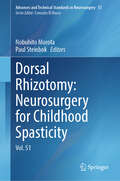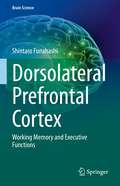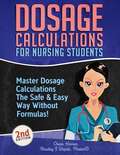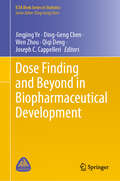- Table View
- List View
Dopamine and Sleep
by Jaime M. Monti S. R. Pandi-Perumal S. ChokrovertyThis book offers a comprehensive but highly readable compilation of papers on the role of dopamine in sleep and sleep disorders. Leading experts in sleep medicine, psychiatry and neuroendocrinology provide a broad perspective on the field, from established theories to the latest research advances. Accordingly, it represents an interdisciplinary, cutting-edge guide for sleep disorder specialists, sleep researchers, psychiatrists, neurologists, pulmonologists, psychologists, and behavioral sleep medicine specialists.
Dopamine in the Gut
by Jin-Xia ZhuDopamine is widely present in the central and peripheral nervous systems, as well as in non-nervous systems. Parkinson's disease is well recognized as a dopaminergic neurodegenerative disorder, and affected patients often show early signs of gastrointestinal disorders at initial stages of the disease. Apart from the changes that occur in emotion, movement behaviors, learning and memory, metabolism etc., dopamine has also been demonstrated to play very crucial roles in the functional regulation of peripheral organs such as the heart, blood vessels, kidneys, and gut. Most recently, dopamine function in the gut has received enormous attention. Not only does dopamine regulate gut motility, ion transport, and mucosal barrier, but it is becoming more pertinent that more than 60% of dopamine in the body stems from the gut, which has not yet been properly addressed and substantially explored. Therefore, this book will discuss the brain-gut axis by providing novel and significant insight into the essence of gut-derived dopamine in mammals. It aims to inspire further research on dopaminergic regulation of gut function and disease genesis.
Dopamine: Endocrine and Oncogenic Functions
by Nira Ben-JonathanDopamine is a small molecule traditionally regarded as a brain-derived neuronal modulator implicated in many neurological and psychiatric disorders. Outside the brain, dopamine fulfills all the criteria of a circulating hormone which affects normal and abnormal functions of multiple organs and regulatory systems and is also involved in many aspects of cancer formation and progression. This book provides a much needed systematic account of dopamine as an endocrine and autocrine/paracrine hormone and fills a major gap in the overall understanding of the production, distribution and actions of this very important molecule. Key Features: Explores the many different faces of dopamine as autocrine, paracrine and endocrine molecule Documents the adverse effects of antipsychotics on dopamine functions Reviews the many ways dopamine affects the cardiovascular, renal and reproductive systems Provides updates on receptor oligomerization and signaling Examines the role of dopamine in tumorigenesis Related Titles Jones, S. ed. Dopamine - Glutamate Interactions in the Basal Ganglia (ISBN 978-0-3673-8197-4) Luo, L. Principles of Neurobiology (ISBN 978-0-8153-4494-0) Sidhu, A. et al., eds. Dopamine Receptors and Transporters (ISBN 978-0-8247-0854-2)
Dopaminergic System Function and Dysfunction: Experimental Approaches (Neuromethods #193)
by José Antonio Fuentealba-Evans Pablo HennyThis volume provides a variety of technical approaches to study dopamine system function and dysfunction. Chapters guide readers through dopamine release in ex vivo and freely moving animals, multi-recording devices for in vivo simultaneous single cell and population activity, in silico modeling of dopamine neurons activity, neuroanatomical approaches, unbiased stereology, ultrastructural analyses of dopaminergic neurons, and axonal innervation. Additionally, chapters also incorporate pharmacological tools to model neuropsychiatric diseases, novel behavioral paradigms to dissect dopamine's role in behavior, and functional imaging to follow human dopamine system development. In the Neuromethods series style, chapters include the kind of detail and key advice from the specialists needed to get successful results in your laboratory.Comprehensive and cutting-edge, Dopamine Neurotransmission aims to be a valuable resource for researchers in various disciplines.
Dopesick: Dealers, Doctors, and the Drug Company that Addicted America
by Beth Macy<P>The only book to fully chart the devastating opioid crisis in America: "a harrowing, deeply compassionate dispatch from the heart of a national emergency" (New York Times) from a bestselling author and journalist who has lived through itIn this masterful work, Beth Macy takes us into the epicenter of America's twenty-plus year struggle with opioid addiction. <P>From distressed small communities in Central Appalachia to wealthy suburbs; from disparate cities to once-idyllic farm towns; it's a heartbreaking trajectory that illustrates how this national crisis has persisted for so long and become so firmly entrenched. <P>Beginning with a single dealer who lands in a small Virginia town and sets about turning high school football stars into heroin overdose statistics, Macy endeavors to answer a grieving mother's question-why her only son died-and comes away with a harrowing story of greed and need. <P>From the introduction of OxyContin in 1996, Macy parses how America embraced a medical culture where overtreatment with painkillers became the norm. In some of the same distressed communities featured in her bestselling book Factory Man, the unemployed use painkillers both to numb the pain of joblessness and pay their bills, while privileged teens trade pills in cul-de-sacs, and even high school standouts fall prey to prostitution, jail, and death. <P>Through unsparing, yet deeply human portraits of the families and first responders struggling to ameliorate this epidemic, each facet of the crisis comes into focus. <P>In these politically fragmented times, Beth Macy shows, astonishingly, that the only thing that unites Americans across geographic and class lines is opioid drug abuse. But in a country unable to provide basic healthcare for all, Macy still finds reason to hope-and signs of the spirit and tenacity necessary in those facing addiction to build a better future for themselves and their families. <P><b>A New York Times Bestseller</b>
Doping and Public Health
by Nader Ahmadi Arne Ljungqvist Göran SvedsäterDoping – the use of performance-enhancing substances and methods – has long been a high-profile issue in sport but in recent years it has also become an issue in wider society. This important new book examines doping as a public health issue, drawing on a multi-disciplinary set of perspectives to explore the prevalence, significance and consequences of doping in wider society. It introduces the epidemiology of doping, examines the historical context, and explores the social, behavioural, legal, ethical and political aspects of doping. The book also discusses possible interventions for addressing the problem on organisational and societal levels. Doping and Public Health incorporates the latest research to provide a comprehensive guide to the key aspects of doping as a social phenomenon. Divided into six parts, this collection of studies offers detailed insight into: ideals of health and fitness in today’s society reasons behind the use of doping medical and social consequences of doping the importance of a doping-free society challenges to the detection and prevention of doping the global anti-doping movement. This book is a valuable resource for sport students, instructors and sport professionals, and will also be of interest to educators and policy-makers working in the areas of health, criminology, sociology and law.
Doping in Cycling: Interdisciplinary Perspectives (Ethics and Sport)
by John Gleaves Bertrand Fincoeur Fabien OhlDoping in Cycling: Interdisciplinary Perspectives provides an up-to-date overview of the knowledge about doping and anti-doping in the sport that has dominated doping headlines for at least two decades. It critically addresses overarching questions related to doping and anti-doping, and topical issues being raised in the agenda of policy-makers at the global level. The book features cross-disciplinary contributions from international leading scholars in sports sociology, history, philosophy, psychology and criminology, and even beyond human and social sciences. Split into three parts (the use and supply of doping products; threats on cycling and opportunities for anti-doping; and issues, controversies, and stakes), it covers topics such as changing patterns of drug use in professional cycling, the impact of scientific advances on doping in cycling, whether cycling teams can prevent doping, whistleblowing on doping in cycling, and how to improve the credibility of the sport. This is a vital resource for researchers, students, policy-makers, anti-doping organisations and sports federations, and an important read for anyone involved in elite cycling.
Doping in Sports
by Peter Hemmersbach Detlef ThiemeDoping in sports and the fight against it has gained increasing attention in recent years. The pharmacological basis for a possible performance enhancement in competitive sport through the administration of prohibited substances and methods as well as the analytical disclosure of such practices are comprehensively covered in 21 contributions by outstanding and distinctive authors.
Doppelgänger: Analysing ‘Doubles' across Antiquity, Fiction, Psychopathology, and Neuroscience
by Femi OyebodeThe concept of doppelgänger, or 'double' – a conceived exact but sometimes invisible replica of a living person – has fascinated and intrigued people for centuries. This notion has a long history and is a widespread belief among cultural groups around the world. Doppelgängers have influenced literature and cinema, with writers such as Fyodor Dostoyevsky and Robert Louis Stevenson, and directors like Alfred Hitchcock exploring the phenomenon to great effect. This book brings together the literary and cinematic with empirical scientific literature to raise fundamental questions about the nature of the self and the human mind. It aims to establish the experience of the self and unravel the brain processes that determine bodily representation and the errors that make possible the experience of the doppelgänger phenomenon. This book will appeal to psychiatrists, neurologists, and neuroscientists, as well as interested general readers.
Doppler Echocardiography for the Small Animal Practitioner (Rapid Reference)
by June A. BoonDoppler Echocardiography for the Small Animal Practitioner Practical guide to using color flow and spectral Doppler in interpreting echocardiographic findings in veterinary practice Doppler Echocardiography for the Small Animal Practitioner provides a clinically oriented quick reference to using color flow and spectral Doppler to interpret echocardiographic findings, enabling readers to learn and apply these techniques and acquire background knowledge of technical factors affecting diagnostic color and spectral Doppler. Practically, the text also serves as a quick checklist for the Doppler features of commonly acquired cardiac diseases in the dog and cat. To aid in reader comprehension, the text contains color images and video clips to support the descriptions. This handbook is not intended as a comprehensive explanation of the echocardiographic features associated with heart disease in animals. Rather, it is intended as the next step for the general practitioner and the non-cardiac specialist that have learned to acquire diagnostic 2D and M-Mode echocardiographic studies. Written by a highly experienced professionals with nearly 40 years of experience in the field of veterinary echocardiography, sample topics covered in Doppler Echocardiography for the Small Animal Practitioner include: Doppler principles as they apply to accuracy and evaluation of the color flow and spectral Doppler examination Imaging planes required for accurate evaluation of flows in the heart and an explanation of and application of Doppler pressure gradients Interpretation of color flow signals and common Doppler features of the most frequently acquired heart diseases in dogs and cats Specific intricacies of the field, including isovolumic relaxation time (IVRT) and imaging planes techniques of the mitral valve and aorta Doppler Echocardiography for the Small Animal Practitioner is a highly valuable resource and practical guide for all professionals in the field who have learned to acquire diagnostic 2D and M-Mode echocardiographic studies and now need to understand how to learn and apply these techniques in a myriad of practical applications. Related Titles Two-Dimensional and M-Mode Echocardiography for the Small Animal Practitioner Second Edition By June Boon 9781119028536 Life-Threatening Cardiac Emergencies for the Small Animal Practitioner By Maureen McMichael and Ryan Fries9781119042075 Cardiology for Veterinary Technicians and Nurses By H. Edward Durham 9780813813530
Doppler Echocardiography in Infancy and Childhood
by Karl-Heinz Deeg Thomas Rupprecht Michael HofbeckThis book covers the full range of Doppler echocardiography in infants and children, documenting the wide variety of potential findings with the aid of a wealth of high‑quality images. The imaging features of more than 20 conditions on conventional two‑dimensional echocardiography, pulsed wave, continuous wave and color Doppler imaging are described and depicted, drawing attention to differential diagnostic criteria and other issues of importance in everyday clinical practice. Each condition is individually addressed, covering all relevant aspects, and helpful information is also provided on the normal examination. The book is supplemented by more than 500 videos demonstrating typical findings of two-dimensional and color Doppler echocardiography. Special chapters focus on the differential diagnosis of cyanotic infants and echocardiography specifically for the neonatologist. The authors' aim in compiling this book is to equip the reader with the knowledge required in order to employ Doppler echocardiography optimally and to interpret findings confidently and correctly. Doppler Echocardiography in Infancy and Childhood will be an invaluable reference for echocardiographers, pediatricians, neonatologists, and pediatric and general radiologists.
Doppler Sonography in Infancy and Childhood
by Karl-Heinz Deeg Thomas Rupprecht Michael HofbeckThis book covers the full range of current applications of Doppler sonography in infancy and childhood, describing the variety of potential findings with the aid of a wealth of images. After an introductory chapter on the physical and technical basis of Doppler sonography, applications of cerebral Doppler sonography in infancy and of transcranial Doppler sonography in childhood are addressed, with numerous examples of imaging appearances. The major part of the book is devoted to Doppler sonography of the brain, face and neck and of the abdomen, covering normal abdominal vessels, liver, spleen, pancreas, and mesenteric and renal circulation. Imaging of the ovaries and testes is also presented, encompassing the differential diagnosis of acute scrotum and other space-occupying lesions of the testis. The book closes by considering Doppler sonography of soft tissue and vascular malformations, and the influence of congenital heart malformations on flow parameters in peripheral arteries. Doppler Sonography in Infancy and Childhood will be an invaluable reference for pediatricians, neonatologists, pediatric sonographers, and pediatric and general radiologists.
Doppler Ultrasound in Obstetrics and Gynecology
by Dev Maulik Christoph C. LeesExpanded and updated edition highlighting current standards and breakthroughs in the technology of Doppler ultrasound Includes latest advances in 3D and color doppler and 4D fetal echocardiography Includes more than 500 illustrations, including more than 150 in color
Dopplersonographie in Geburtshilfe und Gynäkologie
by Horst Steiner Karl-Theo M. SchneiderDie sorgfältig aktualisierte Neuauflage dieses Buchs stellt erneut einen bewährten Leitfaden für die Praxis dar. Erfahrene Kliniker erhalten ein unentbehrliches Nachschlagewerk. Für alle Gynäkologen, die die Dopplersonographie erlernen, bietet es wertvolle Unterstützung.Dargestellt sind die diagnostischen und klinischen Einsatzmöglichkeiten in Pränatal- und Geburtsmedizin, fetaler Echokardiographie, Gynäkologie und Mammadiagnostik sowie der Reproduktionsmedizin.Erfahrene Kursleiter und Kliniker geben Hinweise auf die korrekte Geräteeinstellung bei allen gängigen Indikationen. Empfehlungen aus der Praxis weisen den Leser auf mögliche Fehlerquellen hin und geben ihm Sicherheit bei der Anwendung und Befundung.Viele exzellente Farbabbildungen tragen zum optimalen Verständnis des Gelesenen bei.
Dormire Profondamente e Svegliarsi Con Più Energia!: Trasformate Il Vostro Letto In Un Tappetino Per Combattere La Fatica e Lo Stress
by Dave McAllenRealizzate l'ambito desiderio di superare la fatica e lo stress per cambiare la vostra vita. In “Dormire profondamente e svegliarsi con più energia”, Dave McAllen illustra i consigli e le tecniche che dà ai pazienti che soffrono di affaticamento e vi guida alla scoperta di un modo completamente innovativo di affrontare il problema dello stress. Non avrete bisogno di farmaci per diventare più svegli, attenti ed efficienti. I semplicissimi attrezzi che potete creare in casa comodamente aiuteranno il vostro corpo a ottenere una maggiore mobilità e flessibilità, rimuovendo la rigidità che è la prima responsabile dei dolori alle articolazioni. La vostra vita migliorerà drasticamente. Dopo il primo giorno, sentirete meno dolori al corpo e meno stanchezza. Dave vi mostrerà come rafforzare i muscoli usando solo piccoli pesi per prevenire stiramenti muscolari e riuscire a svolgere facilmente lavori specifici. Scoprite come brevi esercizi a bassa intensità possono aiutarvi a combattere efficacemente il dolore. Su un letto, un tappetino o una scrivania, questi semplici esercizi vi faranno ottenere in pochissimo tempo grandi risultati. Trovate finalmente una via di fuga da quella fastidiosa sensazione di spossatezza che vi colpisce cronicamente.
Dorothea Orem: Self-Care Deficit Theory
by Ms Donna HartwegEncapsulating the work of a classic nursing theorist, this book provides a unique overview of Orem's Self-Care Deficit Model of Nursing. Orem's Model proposes that nursing should be especially concerned with the patient's need to move continuously towards responsible action in self-care in order to sustain life and health or to recover from disease or injury. The actions required of nurses to achieve these goals are clearly described.
Dorothea's War: The Diaries of a First World War Nurse
by Dorothea CrewdsonThe evocative diaries of a young nurse stationed in northern France during the First World War, published for the first time. A rare insight into the great war for fans of CALL THE MIDWIFE.In April 1915, Dorothea Crewdson, a newly trained Red Cross nurse, and her best friend Christie, received instructions to leave for Le Tréport in northern France. Filled with excitement at the prospect of her first paid job, Dorothea began writing a diary. 'Who knows how long we shall really be out here? Seems a good chance from all reports of the campaigns being ended before winter but all is uncertain.'Dorothea would go on to witness and record some of the worst tragedy of the First World War at first hand, though somehow always maintaining her optimism, curiosity and high spirits throughout. The pages of her diaries sparkle with warmth and humour as she describes the day-to-day realities and frustrations of nursing near the frontline of the battlefields, or the pleasure of a beautiful sunset, or a trip 'joy-riding' in the French countryside on one of her precious days off. One day she might be gossiping about her fellow nurses, or confessing to writing her diary while on shift on the ward, or illustrating the scene of the tents collapsing around them on a windy night in one of her vivid sketches. In another entry she describes picking shells out of the beds on the ward after a terrifying air raid (winning a medal for her bravery in the process).Nearly a hundred years on, what shines out above all from the pages of these extraordinarily evocative diaries is a courageous, spirited, compassionate young woman, whose story is made all the more poignant by her tragically premature death at the end of the war just before she was due to return home.
Dorothea's War: The Diaries of a First World War Nurse
by Dorothea CrewdsonThe evocative diaries of a young nurse stationed in northern France during the First World War, published for the first time. A rare insight into the great war for fans of CALL THE MIDWIFE.In April 1915, Dorothea Crewdson, a newly trained Red Cross nurse, and her best friend Christie, received instructions to leave for Le Tréport in northern France. Filled with excitement at the prospect of her first paid job, Dorothea began writing a diary. 'Who knows how long we shall really be out here? Seems a good chance from all reports of the campaigns being ended before winter but all is uncertain.'Dorothea would go on to witness and record some of the worst tragedy of the First World War at first hand, though somehow always maintaining her optimism, curiosity and high spirits throughout. The pages of her diaries sparkle with warmth and humour as she describes the day-to-day realities and frustrations of nursing near the frontline of the battlefields, or the pleasure of a beautiful sunset, or a trip 'joy-riding' in the French countryside on one of her precious days off. One day she might be gossiping about her fellow nurses, or confessing to writing her diary while on shift on the ward, or illustrating the scene of the tents collapsing around them on a windy night in one of her vivid sketches. In another entry she describes picking shells out of the beds on the ward after a terrifying air raid (winning a medal for her bravery in the process).Nearly a hundred years on, what shines out above all from the pages of these extraordinarily evocative diaries is a courageous, spirited, compassionate young woman, whose story is made all the more poignant by her tragically premature death at the end of the war just before she was due to return home.
Dorothea's War: The Diaries of a First World War Nurse
by Dorothea CrewdsonIn April 1915, Dorothea Crewdson, a newly trained Red Cross nurse, and her best friend Christie, received instructions to leave for Le Tr port in northern France. Filled with excitement at the prospect of her first paid job, Dorothea began writing a diary. 'Who knows how long we shall really be out here? Seems a good chance from all reports of the campaigns being ended before winter but all is uncertain.'Dorothea would go on to witness and record some of the worst tragedy of the First World War at first hand, though somehow always maintaining her optimism, curiosity and high spirits throughout.The pages of her diaries sparkle with warmth and humour as she describes the day-to-day realities and frustrations of nursing near the frontline of the battlefields, or the pleasure of a beautiful sunset, or a trip 'joy-riding' in the French countryside on one of her precious days off. One day she might be gossiping about her fellow nurses, or confessing to writing her diary while on shift on the ward, or illustrating the scene of the tents collapsing around them on a windy night in one of her vivid sketches. In another entry she describes picking shells out of the beds on the ward after a terrifying air raid (winning a medal for her bravery in the process).Nearly a hundred years on, what shines out above all from the pages of these extraordinarily evocative diaries is a courageous, spirited, compassionate young woman, whose story is made all the more poignant by her tragically premature death at the end of the war just before she was due to return home.Read by Julia Barrie and Richard Burnip(p) 2015 Orion Publishing Group
Dorothy Hansine Andersen: The Life and Times of the Pioneering Physician-Scientist Who Identified Cystic Fibrosis
by John Scott BairdThis book chronicles the life and accomplishments of Dorothy Hansine Andersen, a pioneering American pathologist and pediatrician who was the first person to define, diagnose, and treat cystic fibrosis.Divided into three parts, the book begins by detailing Anderson’s early life, including being orphaned as an adolescent, her college career, and her laborious start in the medical field. Part II then examines Andersen’s role in defining the new disease “cystic fibrosis of the pancreas” and her career of active engagement in various clinical pursuits and research, both in pathology and pediatrics. Chapters in this section also discuss the numerous attempts made by others to minimize Andersen’s work through gender bias and the Matilda Effect. The book concludes by reviewing the foundations laid for CF, Andersen’s legacy, and her terminal illness. Featuring an engaging narrative style, Dorothy Hansine Andersen is a historically relevant, invaluable text for anyone interested in the life of Dorothy Anderson and the nascence of cystic fibrosis diagnoses.
Dorsal Rhizotomy: Vol. 51 (Advances and Technical Standards in Neurosurgery #51)
by Nobuhito Morota Paul SteinbokThe scope of this book is to disseminate dorsal rhizotomy for treating children with disabling, intractable spasticity caused by various pathologies. The volume is composed of five sections. The first section describes history and neuroanatomical background of dorsal rhizotomy and spasticity, while the second one is about the selection and pre-operative evaluation of surgical candidates. The third section is the key for readers who are going to learn this surgical procedure, and describes the various types of surgical procedures and the intraoperative neurophysiology used in the surgery. The fourth section is focused on postoperative rehabilitation, functional evaluation and long-term outcome after dorsal rhizotomy. The last section describes the future perspective of this technique and explains how to start up a rhizotomy team. Since the concern about dorsal rhizotomy has been re-emerging recently, this publication is highly expected and will be useful for both beginners in rhizotomy and experienced neurosurgeons.
Dorsolateral Prefrontal Cortex: Working Memory and Executive Functions (Brain Science)
by Shintaro FunahashiThe prefrontal cortex is known to play important roles for performing a variety of higher cognitive functions. Among regions of the prefrontal cortex, the dorsolateral prefrontal cortex plays the most important roles for these functions. This book focuses on functions of the dorsolateral prefrontal cortex, summarizes research results obtained mainly by non-human primate studies, and describes neural mechanisms of executive functions that the dorsolateral prefrontal cortex participates. First, to understand the feature of the dorsolateral prefrontal cortex and how its function has been understood, anatomical and functional features of the dorsolateral prefrontal cortex and historical overview of prefrontal functions are described. To understand functions of the prefrontal cortex and neural mechanisms of executive functions, working memory is an important concept and sustained activation during the memory period of working memory tasks is known as a neural mechanism of working memory. Therefore, this book describes features of sustained memory-related activity based on neurophysiological results obtained in the prefrontal cortex and how memory-related activity contributes to executive functions including control of attention, inhibitory control, task management, and planning. And further, this book describes how the dorsolateral prefrontal cortex contributes to neural mechanisms for sensory and motor processing, memory control in multi-task performance, decision-making, metacognition, and top-down control. Thus, this book provides important information regarding neural mechanisms of dorsolateral prefrontal functions to neuroscientists and helps to plan further investigation to understand prefrontal functions in primates and human subjects.
Dos comidas al día: Pierde grasa, revierte el envejecimiento y líbrate de las dietas
by Mark Sisson¿Estás harto de dietas que solo funcionan durante un tiempo? ¿Te confunden las controversias sobre qué es saludable y qué no? Pierde grasa, revierte el envejecimiento y líbrate de las dietas. Para gozar de una buena salud es muy importante fijarse en lo que comes y cuándo comes. Y está científicamente demostrado que el ayuno intermitente tiene beneficios antiinflamatorios, antienvejecimiento, de regeneración celular, inmunológicos y metabólicos. Existen muchas fórmulas para practicarlo, pero no todas valen -no es tan simple como saltarse el desayuno- y hacerlo bien es fundamental. Mark Sisson, experto en salud y bienestar, te presenta un estilo de vida basado en el ayuno intermitente y te enseña cómo quemar grasa corporal y estar sano, con energía y una actitud positiva. Este libro ofrece, además, una rutina de ejercicios accesible y eficaz,estrategias para superar creencias y comportamientos autolimitantes, y técnicas de vanguardia para lograr la composición corporal que deseas. Con cuarenta y dos recetas deliciosas, Dos comidas al día reúne todo lo que necesitas para ponerte en marcha hacia una transformación de tu estilo de vida placentera y duradera. Mark Sisson, experto en salud y bienestar, licenciado en Biología y excampeón de Ironman, es autor de La dieta Keto y una de las voces más importantes del Movimiento de Salud Evolutiva. Brad Kearns es presentador del pódcast B.rad y atleta de élite.
Dosage Calculations for Nursing Students: Master Dosage Calculations The Safe & Easy Way Without Formulas
by Bradley J Wojcik Chase Hassen“Welcome to the second edition of our dosage calculations book! Are you a nursing student, or nurse, who wants to learn a few simple methods of solving dosage calculations without a bunch of formulas? Would you like to raise your hand in your dosage calculation class, after the instructor explains a complicated formula, and ask to approach the white board to show the class a much simpler method? Do you want to go on your clinical knowing that you have a solid foundation in dosage calculations? Do you want to walk into your Nursing Calculations Class on the first day knowing that you can ace all the tests before the course begins? If you answered yes to any of these questions, this book is for you! The book is divided into seven units containing thirty-five chapters. <P><P>Unit 1: Essential Skills: You can't learn to drive a car if you don't understand the function of the steering wheel. The same applies to the following subjects when learning dosage calculations. The Metric System, Apothecary/Avoirdupois/Household Systems, Ratios, Dimensional Analysis (DA) and Ratio Proportion (RP), Rounding Numbers, Military Time. Unit 2: Auxiliary Subjects: Roman Numerals, Scientific Notation. Unit 3: Unit Conversions. Unit 3 covers converting between and within the various systems of measurement using dimensional analysis and ratio proportion. Unit conversions Within the Metric System, Unit Conversions Within the Household System, Unit Conversions Between Metric, Household and Apothecary Systems, Unit Conversions Involving Pounds and Ounces, Unit Conversions Involving Hours and Minutes. Unit 4: Dosage Calculations. Unit 4 builds on the knowledge gained in the previous units and covers dosage calculations, starting with the terminology and set up of problems, then progressing from easy, one-step, problems through multi-step problems. Dosage Calculations-The Basics, Dosage Calculations Levels 1-3, Body Surface Area Dosing Calculations, Pediatric Dosage Calculations, Pediatric Maintenance Fluid Replacement Calculations. Unit 5: IV Flow Rate Calculations. Unit 5 starts with the basic terminology and set up of IV flow rate problems, then moves on to: Simple and Advanced Problems, IV Flow Rate Adjustment Calculations, Heparin Infusion and Adjustment Calculations. Unit 6: Percent and Ratio Strength Calculations, Percent, Percent Strength, Percent Change, Ratio Strength. Unit 7: Miscellaneous Subjects. Reconstitution Calculations, Concentrations and Dilutions, Milliequivalent Calculations, Dosage Calculations Puzzles, Self-Assessment Exam. The book contains over 600 high quality practice problems with answers. We look forward to your feedback!” Chase Hassen and Brad Wojcik.
Dose Finding and Beyond in Biopharmaceutical Development (ICSA Book Series in Statistics)
by Ding-Geng Chen Joseph C. Cappelleri Wen Zhou Jingjing Ye Qiqi DengThis book covers topics in 2 parts: 1) Review of FDA Guidance, 2) Novel Designs and Analyses. While covering basic principles of dose finding, this book details advancements made in drug development. Finding the right dose(s) is one of the most important objectives in new drug development. In Phase I clinical development, one of the objectives is to escalate test doses from low to high. The low doses should be safe, then escalate up to the maximally tolerable dose (MTD). Phase Ⅱ clinical trials then lower test doses to the minimal efficacious dose (MinED). Dose range of a study drug can be thought of as the doses between MinED and MTD. From this dose range, one or a few doses are selected for Phase Ⅲ confirmation. In practice, dose finding is a very difficult in every phase of clinical development for new drugs. The editors brought distinguished researchers and practitioners in biopharmaceuticals and universities, to discuss the statistical procedures, useful methods, and their novel applications in dose finding. The chapters in the book present emerging topics in dose-finding and related interdisciplinary areas. This timely book is a valuable resource to stimulate the development of this growing and exciting field in drug development.
